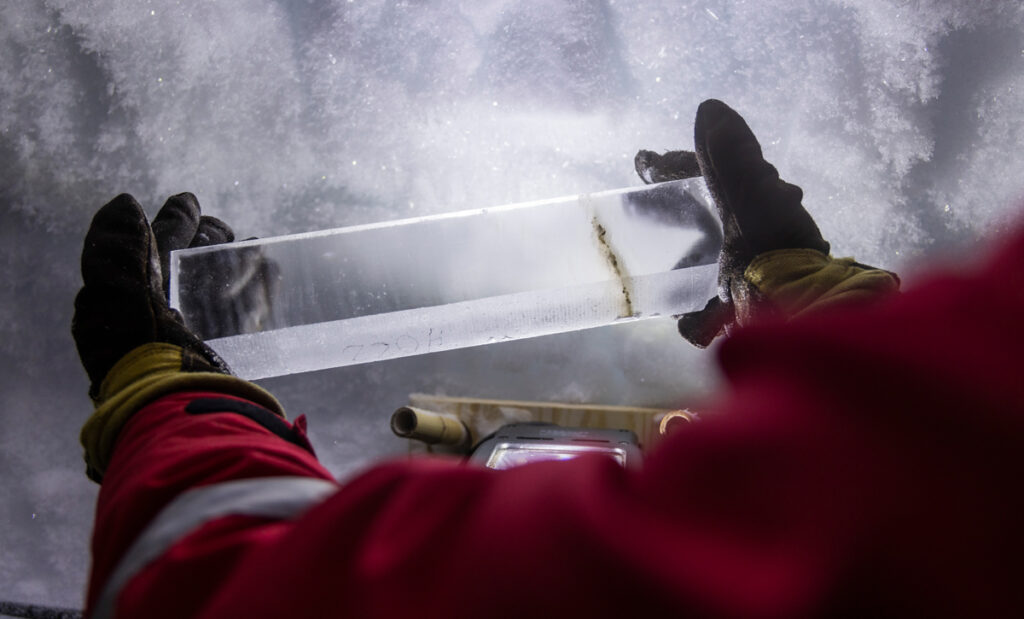The Northeast Greenland Ice Stream is a relatively fast-moving slice of ice. It’s Greenland’s largest ice stream, a frozen tributary that transports roughly 12% of the island’s annual ice discharge into the North Atlantic. That makes it a considerable contributor to sea level rise. But so far, simulations of ice discharge haven’t matched the ice stream’s actual movement. The ice is flowing faster than anticipated.
Seismologists recently made an accidental discovery that may explain the gap. In a new study published in Science, the team detailed how small shifts in the ice are having a big impact on glaciologists’ understanding of ice stream flows.
Quakes in Honey
The results came from the East Greenland Ice-Core Project (EastGRIP), which recently drilled a 2,700-meter borehole directly through the ice stream. On the last day of the 2022 field season, Andreas Fichtner and a colleague were at EastGRIP to set off some explosions, hoping to use the resulting seismic waves to create “an ultrasound image of the ice.” Fichtner is a seismologist at ETH Zürich and lead author of the new study.
The team used a 1,500-meter-long fiber-optic cable to record the waves. They manually unspooled the cable into the borehole, then left to set off their explosives.

Their experiment worked as planned, providing images of the ice stream’s interior. While the cable was installed for 14 hours, however, it recorded other, unexpected seismic signals.
“In honey, you don’t expect things to break.”
“In between those explosions, we expected nothing to happen,” Fichtner explained. Glaciers are assumed to move like a viscous liquid, a thick honey sliding downhill. And “in honey, you don’t expect things to break,” Fichtner said. But when he and his colleagues looked at the data from the cable, they saw five clear seismic events.
Fichtner started analyzing the data that night, initially thinking the five signals were “rubbish,” just noise. But a closer look showed they were cascades of quakes, occurring when a series of microcracks ruptured the ice as it lurched slightly downhill.
A tiny crack would form, radiating small seismic waves. A few milliseconds later, another rupture would be triggered a dozen or so meters higher in the ice. Then another. And another.
Instead of flowing like honey, the ice was sticking and slipping in small bursts.
The cascades were complex, but two of the five were remarkably similar in depth and duration. “It’s like two people accidentally building the same sequence of dominoes,” Fichtner said of the discovery.
Ash on Ice
Surface seismometers hadn’t recorded these tiny ruptures before. The seismic cascades originated deep in the ice and appeared to stop roughly 890 meters below the surface, a depth immediately familiar to Fichtner’s colleagues with expertise in the local ice cores. The ice at 890 meters is roughly 7,600 years old. That’s when Oregon’s Mount Mazama exploded, creating Crater Lake, now part of Crater Lake National Park. The eruption distributed volcanic ash and glass called tephra over parts of North America and Greenland.
Tephra affects the way ice crystals form, creating a structurally weaker layer. Instead of continuing to cascade vertically to the surface, seismic waves triggered short bursts of horizontal movement along the tephra layer instead.

The researchers found that the cascades had originated at depths in the ice known to contain volcanic sulfate, which also creates structurally weak ice. These sulfate layers can also be pinned to specific eruptions. The finding shows how these centimeter-scale features can affect an ice sheet across kilometers, Fichtner said, and further demonstrates the effect of volcanic remnants on Greenland’s ice flow.
We All Scream for Ice Streams
“It changes the way we think about how ice moves,” said Marianne Karplus, a seismologist and geophysicist at the University of Texas at El Paso, about the results. The research team ruled out several possible sources for the seismic signals, she said, such as waves reflecting off the end of the cable or cracks caused by a change in ice crystal orientation. “It seems like they came up with a very interesting and believable explanation.”
“We don’t know everything that we need to know.”
Sridhar Anandakrishnan, a glaciologist at Pennsylvania State University, agreed, noting the results “move us towards a more realistic description of glacier flow.” Models often treat the entire ice sheet as one homogenous block for simplicity’s sake, but “the strain gets concentrated at these layers of the volcanic impurities,” he said.
Anandakrishnan said he’s curious about whether the borehole’s disruption affected the results. But overall, he said, “I think this is really a fantastic result.”
Future ice sheet simulations can incorporate major volcanic events to better understand the movement of flows. That could lead to better predictions of sea level rise.
“We need very accurate representations of the ice if we’re going to make projections for the next 50 or 100 years,” Anandakrishnan said. These new results make it clear: “We don’t know everything that we need to know.”
—J. Besl (@J_Besl), Science Writer

